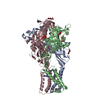+Search query
-Structure paper
| Title | Discovery of Triazolopyrimidine Derivatives as Selective P2X3 Receptor Antagonists Binding to an Unprecedented Allosteric Site as Evidenced by Cryo-Electron Microscopy. |
|---|---|
| Journal, issue, pages | J Med Chem, Vol. 67, Issue 16, Page 14443-14465, Year 2024 |
| Publish date | Aug 22, 2024 |
 Authors Authors | Ga-Ram Kim / Subin Kim / Yeo-Ok Kim / Xuehao Han / Jessica Nagel / Jihyun Kim / Dahin Irene Song / Christa E Müller / Myung-Ha Yoon / Mi Sun Jin / Yong-Chul Kim /    |
| PubMed Abstract | The P2X3 receptor (P2X3R), an ATP-gated cation channel predominantly expressed in C- and Aδ-primary afferent neurons, has been proposed as a drug target for neurological inflammatory diseases, e.g., ...The P2X3 receptor (P2X3R), an ATP-gated cation channel predominantly expressed in C- and Aδ-primary afferent neurons, has been proposed as a drug target for neurological inflammatory diseases, e.g., neuropathic pain, and chronic cough. Aiming to develop novel, selective P2X3R antagonists, tetrazolopyrimidine-based hit compound was optimized through structure-activity relationship studies by modifying the tetrazole core as well as side chain substituents. The optimized antagonist , featuring a cyclopropane-substituted triazolopyrimidine core, displayed potent P2X3R-antagonistic activity (IC = 54.9 nM), 20-fold selectivity versus the heteromeric P2X2/3R, and high selectivity versus other P2XR subtypes. Noncompetitive P2X3R blockade was experimentally confirmed by calcium influx assays. Cryo-electron microscopy revealed that stabilizes the P2X3R in its desensitized state, acting as a molecular barrier to prevent ions from accessing the central pore. In vivo studies in a rat neuropathic pain model (spinal nerve ligation) showed dose-dependent antiallodynic effects of , thus presenting a novel, promising lead structure. |
 External links External links |  J Med Chem / J Med Chem /  PubMed:39102524 PubMed:39102524 |
| Methods | EM (single particle) |
| Resolution | 2.61 Å |
| Structure data | EMDB-60647, PDB-9ik1: |
| Chemicals |  PDB-1l2m:  ChemComp-ATP:  ChemComp-NAG:  ChemComp-MG: |
| Source |
|
 Keywords Keywords | MEMBRANE PROTEIN / P2X3 receptor / compound 26a / Cryo-EM |
 Movie
Movie Controller
Controller Structure viewers
Structure viewers About Yorodumi Papers
About Yorodumi Papers





 homo sapiens (human)
homo sapiens (human)